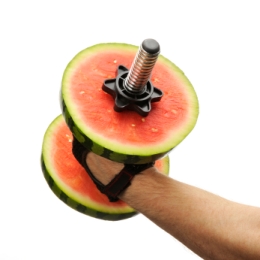Action Plan to Lose Weight for Body Mass Index (BMI) Over 25
If your body mass index is over 25 (calculate it here), then you are overweight and need to start making changes to lose weight. Taking action now will help you to prevent yourself making the transition from overweight to obese. Following a longer weight reduction plan will help you to move towards an ideal weight once again.
Preparation for Change
Prepare yourself and get your body physically and mentally ready to shred the stones and maintain a long-term weight loss strategy. Start by booking a health MOT – If you have any ongoing health problems, such as diabetes or heart condition it is important to speak to your doctor and ask for advise on how much exercise you can do.
Even if you think you are healthy, but you have a large amount of weight to lose and are not used to practice exercise it is best to get a check up with your doctor before you embark on a vigorous exercise regime.
Start the day with a good breakfast
Remember that breakfast is the most important meal of the day as it kick-starts the body’s metabolism after a long night rest. If you skip breakfast you will feel hungry earlier during the day a take the risk of giving in to temptation. So keep the good habit of always eating breakfast.
Think about the final results
Making small changes to your lifestyle can bring important benefits for your health and wellbeing. Just by losing 10% of your body weight you can lessen the risk of developing heart disease and diabetes.
Know what to eat and how much to eat
The basic rule is that in order to lose weight you need to eat fewer calories and exercise more, in this way your body starts to use its fat reserves, and you start to lose weight. Keep a balanced diet that includes fruit and vegetables, protein and carbohydrates.
Get help from family and friends
Tell your friends and family about your plans to lose weight and ask for their support and encouragement. It is easier to keep motivated when you can share your experience with someone else.
Be realistic
Your body will undergo lots of changes during the process of losing weight. Do not be too hard on yourself by expecting to see lots of weight loss straight away. It can take a little time for the body to adjust to the changes in your exercise routine and eating habits. Set small weight loss targets of 1-2 lbs (0.5-1 kg) a week.
Take the healthier choice
It can be hard to resist temptation if they are all around you. So start by getting rid of all the unhealthy food in your house, including high fat and sugar snacks like crisps, chocolates, cake and biscuits and replace them with healthy snacks.
Implement Changes and Plan Ahead
Get started by changing your eating habits and your exercise routine. Don’t rush into these changes, take your time to adjust your lifestyle gradually, in order to maintain a steady weight loss regime for the long-term, slowly but surely.
Take on a calorie goal
Set yourself a target to lose 1 lb-2 lbs (0.5-1 kg) a week, regardless of to what you weigh now. To lose 1 lb a week you will need to reduce 500 calories of your daily intake and to lose 2 lbs a weeks you need to cut 1000 Calories from your daily intake. Women normally lose weight on 1,500 Calories intake a day and men on 1,800.
Start a food diary
It helps you to acknowledge what you eat and how much you eat every day. This gives you the opportunity to make the changes you need in your diet and re-educate yourself about eating habits – helping you to change your life style.
Be honest with yourself. Studies have shown that on average people under report their daily calorie intake by around 50%. So if you think that you are on a fat burning diet of 1000 Calories a day this really may not be the case. Add up all snacks, all bread, all drinks and all side orders on meals.
Start to exercise
Start to exercise gradually and slowly build up your stamina and body condition. Don’t try to over-exercise at the beginning, especially if you haven’t exercised for while, so you don’t strain yourself. Walking is a really good exercise to start with if you have not exercise at all in many years.
To begin with you can exercise for 15 minutes each day and 5 times week. Gradually you can get to a 45 minute walk 7 times a week. Consider starting a walking plan and walk your way to fitness. Always focus on getting fitter, doing more. Move faster for longer. If walking is not working you hard enough it may be time to start running or finding another form of exercise.
Choose the right exercise for you
Keep active and enjoy yourself at the same time by doing some type of exercise that you like, such as swimming or cycling. You are more likely to keep exercising when you do something that you enjoy. Remember, the type of exercise that you do makes little difference when it comes to burning fat, what is important is the amount of exercise. Exercise on a regular basis.
The scale rule
Use an imaginary scale from 1 to 5 to access your hunger, one means you are not hungry at all – 5 means you are starving. Be strong and only eat if you get to number 4, as the feeling of being hungry can pass quickly. Distract your mind by keeping busy and drink some water, the hunger feeling will pass.
Trick your cravings
You need to have a strong willpower to keep the cravings away. Use distraction to stop yourself from snacking and bingeing. Whenever you start craving occupy yourself with something that will take your mind out of it. Music is something that can lift your spirit up – so listen to your favorite songs and dance around the house and forget about food.
Keep motivated
Reward yourself to a non-food-based treat each time you reach a new goal as a way to keep yourself motivated – buy a magazine, CD or make-up for instance.
Read the food labels
The NHS provide a guide to understanding food labels (nhs.uk) can help you to choose a healthier diet. The traffic-light food labeling system is easy to use – red, yellow and green means high, medium and low levels of fat, salt and sugar retrospectively. Aim to eat more food with the green labels and less of the red labels.
Action 3 – Develop a Positive New Lifestyle
This final part is about changing your lifestyle to achieve a healthy weight for a lifetime and feel good about yourself, this can take several months but it is worth persevere.
Join the gym or class
As you are now exercising on a regular basis, it is time to take a step further and increase the frequency and intensity of your workouts. The advantages of joining a gym or your local fitness class is that you get the chance to exercise with other people and practice the activities you enjoy.
Exercise is vital for weight loss, as you get fitter increase the intensity of your exercises, keeping your heart rate to its optimum level. Try intensity training five times a week for 30-45 minutes each time.
Stay healthy
Have your five portions of fruit and vegetables every day as they have plenty of vitamins and water as well as being low-calorie, helping you to stay healthy. During the main mealtimes, opt for food with lean protein, such as fish, skinless chicken, pulses and beans.
Meet people
Have some fun with family and friends and enjoy yourself, this helps you to unwind and feel good about yourself.
Keep food fun
It is important to enjoy what you eat, keep your new diet interesting, so you don’t get bored with it. Try different foods you haven’t had before, like exotic fruits, such as lychees, dragon fruit, passion fruit etc. Learn to prepare some interest healthy dishes with a new cooking book can help you to make some nice healthy meals.
Drink plenty of water
Drink between six to eight glasses of water a day to help you digest your meals, prevent bloating and carry nutrients around your body. Exercise also speeds dehydration which can reduce future workouts. Many people are borderline dehydrated without realizing, and this affects their cognitive ability, energy levels and general healthy. Latest research indicates that although there is no set minimum requirement for water consumption each day it is important not to ignore thirst.
Maintain a healthy weight
These are changes for a lifetime, keep healthy with your new lifestyle and feel better for it. Minimise the sugar and the fat contents from your diet for good, enjoy healthy meals and don’t feel hungry. Consider following a low to medium GI diet plan to help control food cravings and blood sugar levels.
Be proud of yourself and make exercise part of your daily routine for life. Monitor your weight regularly so that if your weight starts to increase you cane make immediate changes to recovery quickly.
Once you have lost weight and started getting fit the task of maintaining a healthy body becomes so much easier. Never despair, never give up. Remember that you only have one life, one body, so look after it.
References
“Discrepancy between Self-Reported and Actual Caloric Intake and Exercise in Obese Subjects” by Steven W. Lichtman, Ed.D., Krystyna Pisarska, M.S., Ellen Raynes Berman, Psy.D., Michele Pestone, M.S., Hillary Dowling, Ph.D., Esther Offenbacher, Ed.D., Hope Weisel, M.S., R.D., Stanley Heshka, Ph.D., Dwight E. Matthews, Ph.D., and Steven B. Heymsfield, M.D. Published in New England Journal of Medicine 1992; 327:1893-1898 December 31, 1992.
“Eat Your Water for Health, Sport Performance, and Weight Control” by Victoria J. Vieira Potter, PhD. Published in AMERICAN JOURNAL OF LIFESTYLE MEDICINE May 26, 2011 1559827611405148
-
How To Reduce Fat – Basic Tips
How to reduce fat and burn fat can be monotonous to learn about, and e
-
Still Counting Calories? Think Again
At one time or another, weve all been promised this: If the am
-
Weight Loss Exercise - A Great Start
I realize this sounds like a broken record, but if you want to loo
-
The Homemade Drink That Burns Calories
Burning calories is one of the number one ways to lose weight. This is
-
Can Grapefruit Help In Cutting Overweight Problems?
The grapefruit diet is not a new concept. The original plan was develo
-
10 Great Ways To Burn More Fat
You have your hands full with work, school, family or any combination
- DON'T MISS
- The Dark Side Of Phentermine
- How to Lose Weight Fast and Not Destroy Your Muscle Fibers
- Turbulence Training Ebook -Download Turbulence Training
- Is It Possible To Lose 3 Pounds In 2 Days?
- Beneficial Nutrition to Stick to With HCG Diet Program
- What Is The Thought Loop That Panic Away Talks About?
- Are You Controlled By The Urge To Splurge
- Stop a Weight Loss Plateau from Occurring
- How To Find The Best Diet For You
- Cant Lose Weight It May Not Be Your Fault




